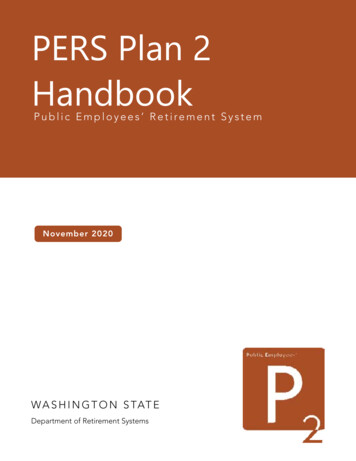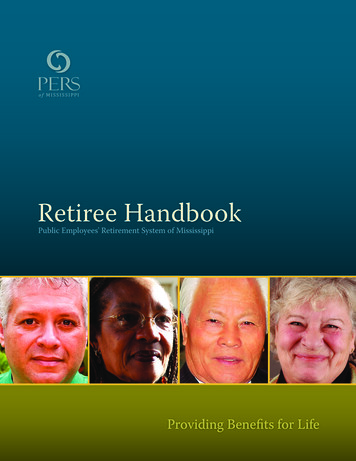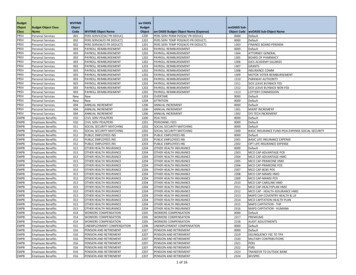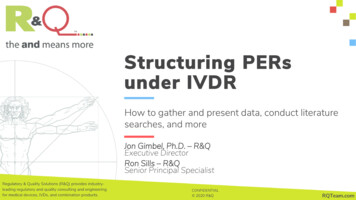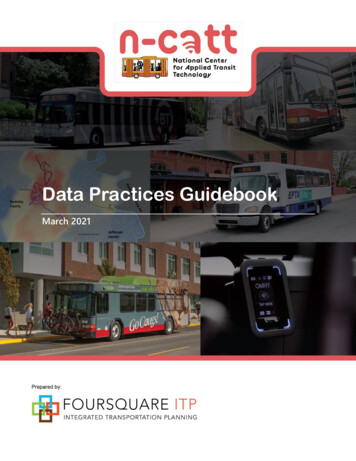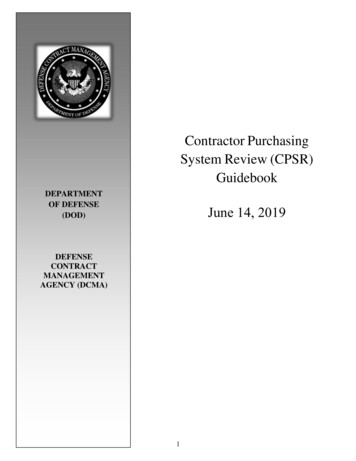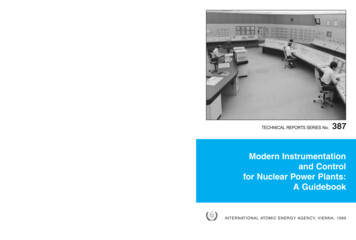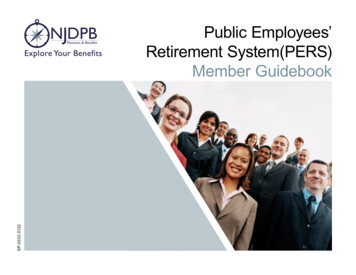
Transcription
SP-0333-0122Pensions & BenefitsPublic Employees’Retirement System(PERS)Member Guidebook
Public Employee’s Retirement SystemTABLE OF CONTENTSSupplementing your Pension. . . . . . . . . . . . . . . . . 23PERS General Information. . . . . . . . . . . . . . . . . . . . 3Overview . . . . . . . . . . . . . . . . . . . . . . . . . . . . . . . 24Foreword . . . . . . . . . . . . . . . . . . . . . . . . . . . . . . . 4Retirements. . . . . . . . . . . . . . . . . . . . . . . . . . . . . . . 25The Retirement System. . . . . . . . . . . . . . . . . . . . . 4Overview . . . . . . . . . . . . . . . . . . . . . . . . . . . . . . . 26Contacting the New Jersey Division ofPensions & Benefits (NJDPB). . . . . . . . . . . . . . . . 4Types of Retirement. . . . . . . . . . . . . . . . . . . . . . . 26Plan Information. . . . . . . . . . . . . . . . . . . . . . . . . . . 5The Retirement Process . . . . . . . . . . . . . . . . . . . 31Eligibility. . . . . . . . . . . . . . . . . . . . . . . . . . . . . . . . . . . 6Membership. . . . . . . . . . . . . . . . . . . . . . . . . . . . . . 7Part-time Crossing Guards. . . . . . . . . . . . . . . . . . 8Elected or Appointed Officials . . . . . . . . . . . . . . . . 8Enrollments . . . . . . . . . . . . . . . . . . . . . . . . . . . . . . . . 9Overview . . . . . . . . . . . . . . . . . . . . . . . . . . . . . . . 10Multiple and Dual Membership. . . . . . . . . . . . . . 11Transfers . . . . . . . . . . . . . . . . . . . . . . . . . . . . . . . 12Service Credit. . . . . . . . . . . . . . . . . . . . . . . . . . . 13Vesting. . . . . . . . . . . . . . . . . . . . . . . . . . . . . . . . . 13Purchasing Service Credit. . . . . . . . . . . . . . . . . . . 14Overview . . . . . . . . . . . . . . . . . . . . . . . . . . . . . . . 15Types of Service Eligible for Purchase. . . . . . . . 15Important Purchase Notes. . . . . . . . . . . . . . . . . . 16Cost and Procedures forPurchasing Service Credit. . . . . . . . . . . . . . . . . . 16Applying to Purchase Service Credit. . . . . . . . . . 17Loans . . . . . . . . . . . . . . . . . . . . . . . . . . . . . . . . . . . . 19Overview . . . . . . . . . . . . . . . . . . . . . . . . . . . . . . . 20Applying for a Loan . . . . . . . . . . . . . . . . . . . . . . . 21Optional Settlements at Retirement. . . . . . . . . . . 30Reduction or Suspension of Your Benefits. . . . . . 35Employment After Retirement . . . . . . . . . . . . . . . 36Active and Retired Death Benefits. . . . . . . . . . . . . 37Overview . . . . . . . . . . . . . . . . . . . . . . . . . . . . . . . 38Choosing a Beneficiary . . . . . . . . . . . . . . . . . . . . 39Payment of Group Life Insurance . . . . . . . . . . . . 39Group Life Insurance andLeave of Absence. . . . . . . . . . . . . . . . . . . . . . . . 39Taxation of Group LifeInsurance Premiums . . . . . . . . . . . . . . . . . . . . . . 40Waiving Noncontributory GroupLife Insurance over 50,000. . . . . . . . . . . . . . . . 40Conversion of Group Life Insurance . . . . . . . . . . 41Accidental Death Benefit. . . . . . . . . . . . . . . . . . . 41Withdrawal. . . . . . . . . . . . . . . . . . . . . . . . . . . . . . . . 43Overview . . . . . . . . . . . . . . . . . . . . . . . . . . . . . . . 44Withdrawing Contributions. . . . . . . . . . . . . . . . . . 45Workers’ Compensation. . . . . . . . . . . . . . . . . . . . 45Appeals. . . . . . . . . . . . . . . . . . . . . . . . . . . . . . . . . . 47Overview . . . . . . . . . . . . . . . . . . . . . . . . . . . . . . . 48Internal Revenue Service (IRS)Requirements. . . . . . . . . . . . . . . . . . . . . . . . . . . . 21PERS Member GuidebookJanuary 2022Page 2
PERS GeneralInformation
Public Employee’s Retirement SystemFOREWORDThe New Jersey Public Employees’ Retirement System (PERS) Member Guidebook provides a summary description of the benefits of the plan and outlinesthe rules and regulations governing the plan. ThePERS Member Guidebook should provide you with allthe information you need about your PERS benefits.However, if there is a conflict with statutes governingthe plan or regulations implementing the statutes, thestatutes and regulations will take precedence. Complete terms governing any employee benefit programare set forth in the New Jersey Statutes Annotated.Regulations, new or amended, are published in theNew Jersey Register by the State Office of Administrative Law supplementing the New Jersey Administrative Code. This guidebook, containing currentupdates, is available for viewing on our website at:www.nj.gov/treasury/pensions While at the New Jersey Division of Pensions & Benefits (NJDPB) website,be sure to check for PERS-related forms, fact sheets,and news affecting the PERS.Addenda guidebooks have been created for the LawEnforcement Officers, Legislative Retirement System,Prosecutors Part, and Workers’ Compensation JudgesPart, which are components of the PERS, but have significantly different benefits. The addenda are availablefor viewing on our website.The purpose of this guidebook is to provide you withinformation about the retirement system to assist youin making decisions concerning you and your family’sfuture. If you have questions concerning your retirement system benefits, please see the “Contacting theState of New Jersey Division of Pensions & Benefits(NJDPB)” section.Since this is your guidebook, we would appreciate anycomments or suggestions for improvement that youmight have. Please send them to the address listed below.New Jersey Division of Pensions & BenefitsATTN: Office of CommunicationsP.O. Box 295Trenton, NJ 08625-0295THE RETIREMENT SYSTEMThe State of New Jersey established the PERS in 1955to replace the former State Employees’ RetirementSystem. The NJDPB is assigned all administrativefunctions of the retirement system except for investment.The PERS Board of Trustees has the responsibilityfor the proper operation of the retirement system. TheBoard consists of: Six employee representatives; The State Treasurer; and Two individuals appointed by the Governor.The Board meets once per month. A PERS memberwho wishes to be a candidate upon a vacancy for thePERS Board of Trustees must be nominated by petitions bearing the signatures of 500 active members.Nominating petition forms, along with instructionsfor filing, are available upon written request to theNew Jersey Division of Pensions & Benefits, Secretaryof the PERS Board of Trustees, P.O. Box 295, Trenton,NJ 08625-0295.CONTACTING THE NEW JERSEYDIVISION OF PENSIONS & BENEFITS (NJDPB)Member Benefits Online SystemThe Member Benefits Online System (MBOS) allowsregistered PERS members access to their pensionPERS Member GuidebookJanuary 2022and, if applicable, health benefits account informationonline. Resources available through MBOS include:member account information; beneficiary designation;pension loan; purchase of service credit; withdrawalapplication; and retirement applications. If applicable,account information for the New Jersey State Employees’ Deferred Compensation Plan (NJSEDCP), Supplemental Annuity Collective Trust (SACT), and StateHealth Benefits Program (SHBP) or School Employees’Health Benefits Program (SEHBP) is also available.Retirees may use MBOS to: view retirement accountinformation; update an address; change direct depositinformation; change a beneficiary designation; or update federal and/or New Jersey State income tax withholding.Before you can begin using MBOS, you must be registered with MBOS and the MyNewJersey website.Registration information can be found on the NJDPBwebsite.If you need assistance registering for MBOS, callthe MBOS Help Line at (609) 292-7524 or sendan email with the subject line “MBOS Email” to:pensions.nj@treas.nj.govTelephone Numbers For computerized information about your individual pension account 24 hours a day, seven daysa week, call our Automated Information System at(609) 292-7524. With Interactive Voice Responseand added services, all you need is your SocialSecurity number and membership number to hearpersonalized benefits information on purchases,retirement benefits, and withdrawal. To speak with a representative about your PERSaccount or health benefits account, call (609) 2927524 weekdays (except State holidays). The mostcurrent hours of operation can be found on ourPage 4
Public Employee’s Retirement Systemwebsite. If you require the services of a relay operator please dial 711 and provide the operator withthe following phone number, (609) 292-6683. Youwill then be connected to a Client Services phonerepresentative for assistance. To speak with a plan representative about theNJSEDCP, also known as Deferred Comp, callPrudential at 1-866-NJSEDCP (1-866-657-3327)weekdays between 8:00 a.m. and 9:00 p.m. (except State holidays). A plan representative will answer your questions and provide enrollment anddistribution forms. To speak with a plan representative about theSACT, call (609) 292-7524 weekdays (except Stateholidays). The most current hours of operation canbe found on our website. SACT representativeswill answer your questions and provide enrollmentand distribution forms.Internet, Email, and Mailing AddressGeneral information and most publications of theNJDPB can be found on the NJDPB website. You canemail the NJDPB at: pensions.nj@treas.nj.govOur postal address is:New Jersey Division of Pensions & BenefitsP.O. Box 295Trenton, NJ 08625-0295On all correspondence, be sure to include your membership number or the last four digits of your Social Security number.Counseling ServicesThe NJDPB offers counseling services to members ofthe retirement systems and benefit programs. Counselors are available by appointment Monday throughFriday, 8:00 a.m. to 4:00 p.m., with the last interviewstaken at 3:30 p.m. Walk-in counseling services are alsoPage 5available on a first come, first served basis; however,clients with scheduled appointments will be seen first.Therefore, it is recommended you make an appointment. Appointments can be made on our website.PLAN INFORMATIONName of PlanThe Public Employees’ Retirement System of New Jersey (PERS)AdministrationThe PERS is a defined benefit plan administered by theNew Jersey Division of Pensions & Benefits (NJDPB).Provisions of LawThe PERS was established by New Jersey Statute andcan be found in the New Jersey Statutes Annotated,Title 43, Chapter 15A. Changes in the law can only bemade by an act of the State Legislature. Rules governing the operation and administration of the system maybe found in Title 17, Chapters 1 and 2 of the New JerseyAdministrative Code.Employment Rights Not ImpliedMembership in the PERS does not give you the right tobe retained in the employ of a participating employer,nor does it give you a right of claim to any benefit youhave not accrued under terms of the system.Benefits and provisions of the PERS are subjectto changes by the legislature, courts, and otherofficials. While this guidebook outlines the benefit and contribution schedules of the PERS, itis not a final statement. Complete terms governing any employee benefit program are set forthin the New Jersey Statutes Annotated. Regulations, new or amended, are published in theNew Jersey Register by the State Office of Administrative Law supplementing the New JerseyAdministrative Code.FundingThe funds used to pay benefits come from three sources: employer contributions, employee contributions,and investment income from those contributions. Allcontributions not required for current operations are invested by the State Division of Investment.Plan YearFor record-keeping purposes, the plan year is July 1through June 30.Service of Legal ProcessLegal process must be served on the Attorney Generalof New Jersey pursuant to New Jersey Court Rules, R.4:4-4(7).January 2022PERS Member Guidebook
Eligibility
Public Employee’s Retirement SystemMEMBERSHIPEligibility rules and regulations are described in generalterms in this guidebook and may not cover all situations. If you have been a public employee for severalyears, you should be aware that the present rules andregulations governing enrollment in the retirement system differ from past rules and regulations. If you havespecific questions concerning your date of enrollmentor membership status, you may wish to contact theNJDPB for additional information.PERS Special Employee GroupsThe information contained in this guidebook appliesto the majority of the members enrolled in the PERS.However, certain members of the PERS qualify for enrollment into special employee groups: Law Enforcement Officers (LEO); Prosecutors Part of the PERS (closed to newmembers May 22, 2010, and reopened September24, 2021); State Legislative Retirement System (LRS) of thePERS (closed to new members July 1, 2007); and Workers’ Compensation Judges (WCJ) Part of thePERS (reopened to new members and certain existing Defined Contribution Retirement Program(DCRP) members as of June 30, 2021.are defined as follows: Membership Tier 1 — Members enrolled prior toJuly 1, 2007, and who have a minimum pensionable salary of 1,500. Membership Tier 2 — Members enrolled on orafter July 1, 2007, and prior to November 2, 2008,and who have a minimum pensionable salary of 1,500. Membership Tier 3 — Members enrolled on orafter November 2, 2008, and on or before May 21,2010, and who meet or exceed the minimum pensionable salary set for the current year, subject tofuture adjustment. Membership Tier 4 — Members enrolled afterMay 21, 2010, and prior to June 28, 2011, and whowork the minimum number of hours per week (fixedhours of 35 hours for State employees or 32 hoursfor local government, local education, or State education employees), with no minimum pensionablesalary requirement. Membership Tier 5 — Members enrolled on orafter June 28, 2011, and who work the minimumnumber of hours per week (fixed hours of 35 hoursfor State employees or 32 hours for local government, local education, or State education employees), with no minimum pensionable salary requirement.Members of these special employee groups should refer to the PERS Guidebook Addendum specific to theiremployee group for exceptions to the regular PERSrules and benefits. These exceptions are also notedunder the section headings in this guidebook.Unless otherwise indicated by membership tier — withthe exceptions noted above for LEO, LRS, ProsecutorsPart, and WCJ Part members — the benefits listed inthis guidebook are the same for all PERS members.PERS Membership TiersEligibility CriteriaPERS members are categorized by specific membership tiers based on enrollment date. Membership tiersaffect a member’s enrollment and retirement eligibility.These membership tiers, pursuant to N.J.S.A. 43:1A-7Membership in the retirement system is generally required as a condition of employment for most employees of the State, or any county, municipality, schooldistrict, or public agency.Page 7January 2022You are required to enroll in the PERS if: You are employed on a regular basis in a positioncovered by Social Security; and You are not required to be a member of any otherState or local government retirement system onthe basis of the same position;or if: You are receiving a monthly retirement allowancefrom the PERS and you work more than the minimum number of hours per week required for PERSTier 5 enrollment.Note: See the Employment After Retirement Restrictions Fact Sheet about federal tax implications if retiredand returning to public employment.Although most employees are required to enroll in theretirement system when hired, in some instances youmay not qualify for enrollment in the system until up toone year from your date of employment. For example,if you are hired as a temporary or provisional employeeby an employer covered by Civil Service, you would notbe eligible for enrollment until the beginning of the 13thmonth of continuous employment or the date of regularappointment, whichever comes first.Factors for IneligibilityYou cannot join the PERS if: You are a provisional or temporary employee covered by Civil Service with less than 12 months ofcontinuous service. You do not meet the minimum salary requirementsfor Tier 1, 2, or 3 membership or the minimumhourly requirements for Tier 4 or 5 membership. Your position is not covered by Social Security.PERS Member Guidebook
Public Employee’s Retirement System You are a seasonal employee (defined as occasionally working in a position that does not leadto permanent employment, and does not extendbeyond six consecutive months for employing locations that report on a 12-month basis, or fivemonths for employing locations that report on a10-month basis). You are a retired PERS member, with a bona fideretirement, who returns to public employment on apart-time basis. You are a PERS disability retiree who has beenapproved to return to PERS-covered employment,but do not earn the minimum annual salary for enrollment under your original PERS membershiptier. You are retired and receiving a monthly retirementallowance from another public retirement system inNew Jersey. You received a lump-sum retirement distribution from the Alternate Benefit Program (ABP) orDCRP, regardless of distribution amount. You are employed under a Professional ServicesContract.rollment of part-time crossing guards depended on several factors: Enrollment was optional if the part-time crossingguard was receiving periodic retirement benefitsfrom the federal government (whether military, civilian, or Social Security benefits). A crossing guard who had previously retired fromany public retirement system in New Jersey, other than the PERS, was ineligible for enrollment,though he or she could still be employed in thecrossing guard position. If a crossing guard was retired from the PERS, andearned more than 15,000 total from PERS employment, then enrollment was mandatory.If you had the option and chose to join the retirementsystem, you cannot withdraw your funds until you endyour employment.ELECTED OR APPOINTED OFFICIALSState or local officials who are newly elected and takeoffice on or after July 1, 2007, are ineligible for enrollment in the PERS. Elected officials may be eligible forenrollment in the DCRP.PART-TIME CROSSING GUARDSPrior to July 1, 2007, elected officials who qualified asveterans were required to enroll in the PERS and enrollment was optional for non-veteran elected officials.These members may continue to receive PERS servicecredit while serving continuously in the same electedoffice. If, however, an individual is elected to a differentelected office, PERS membership will end and the newly elected official may only be eligible for membershipin the DCRP. See the “Defined Contribution RetirementProgram (DCRP)” section.Part-time crossing guards hired after May 21, 2010, areineligible for enrollment in the PERS, as they do notwork the minimum number of hours per week requiredfor Tier 4 or 5 membership. Prior to May 21, 2010, en-Note: Service in either House of the State Legislatureis considered a single elected public office — see additional information in the PERS Guidebook Addendumfor the LRS. You are a newly elected State or local official (seesection to follow). You are a newly appointed State or local officialand do not have an existing PERS account (seebelow).If you are in doubt about the eligibility of a position,have your employer contact the NJDPB.PERS Member GuidebookJanuary 2022In addition, any non-veteran elected official who waselected prior to July 1, 2007, and opted not to enroll inthe PERS, will immediately become eligible for membership in the DCRP upon re-election to the sameelected office or if elected to a different elected office.See the “Defined Contribution Retirement Program(DCRP)” section.Elected officials who are PERS multiple membersshould see the “Note” in the “Multiple Membership”section.A State or local official who is newly appointed by theGovernor on or after July 1, 2007, is ineligible for enrollment in the PERS. This includes: those requiring theadvice and consent of the Senate; those appointed bythe Governor to serve at the pleasure of the Governoronly during his or her term of office; or those appointedin a substantially similar manner by the governing bodyof a local entity (county, municipality, etc.). Newly appointed officials are eligible for enrollment in the DCRP.See the “Defined Contribution Retirement Program(DCRP)” section.If the State or local appointee was a PERS member prior to July 1, 2007, the individual may continue to receivePERS service credit while serving in the same, or anynew or subsequent appointment, provided that therehas not been a break in PERS service of more than twoconsecutive years prior to the appointment.In addition, an appointee may be enrolled in the PERSif the individual holds a professional license or certificate and is appointed to one of the following titles thatare excluded from DCRP enrollment: certified healthofficer; tax assessor; tax collector; municipal planner;chief financial officer; registered municipal clerk; construction code official; licensed uniform subcode inspector; qualified purchasing agent; or certified publicworks manager.Page 8
Enrollments
Public Employee’s Retirement SystemOVERVIEW(Prosecutors Part members see addendum)Enrollment/Certification of Payroll DeductionsYour employer must complete an Enrollment Application through the Employer Pensions and BenefitsInformation Connection (EPIC).Online enrollments are processed immediately by theNJDPB. You and the employer receive a confirmationthat includes your PERS membership number.When enrollment processing is complete, you and youremployer will receive a Certification of Payroll Deductions with the date pension deductions will begin, yourrate of contribution, and any back deductions due.You may wish to keep the Certification of Payroll Deductions on file with your other important papers sothat you have a record of your enrollment in the retirement system.Proof of AgeAll members of the PERS must provide documentationthat proves their age. If possible, you should provideyour proof of age to the NJDPB when you enroll; however, it does not delay the processing of your enrollment application if you do not. Proof of age will be required to be eligible to retire.Acceptable evidence of your age includes a photocopyof: Birth certificate — with visible seal; Passport or U.S. Passport Card; A current digital New Jersey driver’s license oridentification card (for non-drivers) issued by theN.J. Motor Vehicle Commission;PERS Member Guidebook A current digital Pennsylvania or New York driver’slicense; or Naturalization or immigration papers.Unacceptable documentation includes military recordsindicating your age, expired documentation, out-ofstate driver’s licenses except P.A. and N.Y., hospitalbirth certificates, marriage certificates, census records, baptismal records, or affidavits from older familymembers.Designating a BeneficiaryWhen the Enrollment Application is submitted, the newmember should also submit a Designation of Beneficiary through MBOS. Your PERS membership numberis required and is included in the confirmation of youronline enrollment.Note: The new member’s estate is the beneficiary onrecord until the NJDPB receives a properly completeddesignation.For your protection, beneficiary designations cannotbe accepted or confirmed over the telephone or byemail. Members can verify beneficiary designations onMBOS. Otherwise, the NJDPB will only accept a written request for verification from the member.Life Insurance Over Age 60A member must prove insurability when age 60 or olderat the time of enrollment — this is validated by Prudential Financial.Public Information and RestrictionsMost of the information maintained by the retirementsystem, including member salary and/or pension benefit information, is considered a public record underN.J.S.A. 47:1A-1 et seq., the Open Public Records Act(OPRA). However, certain personal information, suchas a member’s address, telephone number, Social Se-January 2022curity number, pension membership numbers, beneficiary information while the member is living, and medical information is restricted from public access.Further restrictions to personal health information exist under the privacy provisions of the federal HealthInsurance Portability and Accountability Act (HIPAA).Members may be required to provide specific writtenauthorization for the release of medical information toa third party who is not a doctor, hospital, or businesspartner of the NJDPB or the health benefit programs.Information about HIPAA is available on the NJDPBwebsite.The NJDPB has implemented additional protection formembers in accordance with the New Jersey IdentityTheft Prevention Act, N.J.S.A. 56:11-28 et seq. Security Freeze procedures are available to restrict accessto the accounts of members who are, or have a seriousrisk of becoming, victims of identity theft. Additionalinformation is available in the Identity Theft and YourBenefits Fact Sheet.Member Contribution RateN.J.S.A. 43:15A-25, the Pension and Health BenefitReform Law, increased the PERS member contributionrate over seven years to bring the total contribution rateto 7.5 percent of base salary as of July 1, 2018.Note: For PERS Prosecutors Part members, the contribution rate is 10 percent of base salary with no additional increases.Increases in the member contribution rate also increased the minimum repayment amount for pensionloans or for the cost of a purchase of service creditif the repayment is certified after the date of the ratechange.Pensionable Salary — Your contribution rate is applied to your base salary to determine pension deductions. Base salary does not include overtime, bonuses,Page 10
Public Employee’s Retirement Systemor large increases in compensation paid primarily inanticipation of retirement. Your pension contributionsare deducted from your salary each pay period and reported to the PERS by your employer. The PERS contribution rate for Tier 1 members isapplied to the full pensionable salary (up to the federal pensionable maximum described later in thissection). The PERS contribution rate for Tier 2, Tier 3, Tier4, and Tier 5 members is applied to the pensionable salary up to a compensation limit based onthe annual maximum wage for Social Security deductions. Tier 2, Tier 3, Tier 4, and Tier 5 memberswho earn in excess of the annual compensationlimit will be enrolled in the DCRP in addition to thePERS. A contribution of 5.5 percent of the salaryin excess of the limit (plus three percent from theemployer) will be forwarded to a DCRP account(see the “Defined Contribution Retirement Program (DCRP)” section).Federal Pensionable Maximum — Since the PERSis a qualified pension plan under the provisions of theInternal Revenue Code (IRC), Section 401(a)(17), thecurrent federal ceiling on pensionable compensationapplies to the base salaries of PERS members.Tax Deferral — Since January 1987, all mandatorypension contributions to the PERS have been federally tax deferred. Under the 414(h) provisions of theIRC, this reduces your gross wages subject to federalincome tax. Purchases of service credit are voluntaryand are not tax deferred unless funded by a rolloverfrom another tax-deferred plan. See the “Rollover forPurchase Payment” section.Page 11MULTIPLE & DUAL MEMBERSHIPMultiple MembershipYou are considered a multiple member if you are employed and reported to the retirement system by morethan one PERS-participating employer at the sametime.Note: If terminating PERS employment and acceptingemployment at a new PERS employer, see the “Transfers” section.Tier 1, Tier 2, and Tier 3 Members — Under the provisions of N.J.S.A. 43:15A-7, multiple membership is onlyavailable to Tier 1, Tier 2, and Tier 3 members; onlyfor PERS-eligible positions when enrolled on or beforeMay 21, 2010; and provided that there has not been abreak in service in any concurrently held PERS-eligibleposition.Note: A break in service is any pension-reporting period without pay — a monthly or a biweekly pay period asappropriate to the employer’s reporting method — withthe exception of approved leaves of absence, lay-off,abolishment of position, military leave, Workers’ Compensation, litigation, or suspension.If there is a break in service with any concurrently heldPERS-eligible position after May 21, 2010, that employer will no longer be permitted to submit pension contributions for a multiple member. Furthermore, servicecredit or salary from any future employment with thatemployer will not qualify for the compensation base forpension contributions and calculation of retirement forthe PERS multiple member.Once you have established multiple membership, youcannot withdraw or collect retirement benefits until youhave retired or terminated employment from every position covered by the PERS.January 2022Tier 4 and Tier 5 Members — N.J.S.A. 43:15A-25.2eliminated multiple membership and requires that aPERS member enrolled after May 21, 2010, be eligiblefor Tier 4 or
Public Employees' Retirement System(PERS) Member Guidebook Pensions & Benefits SP-0333-0122
